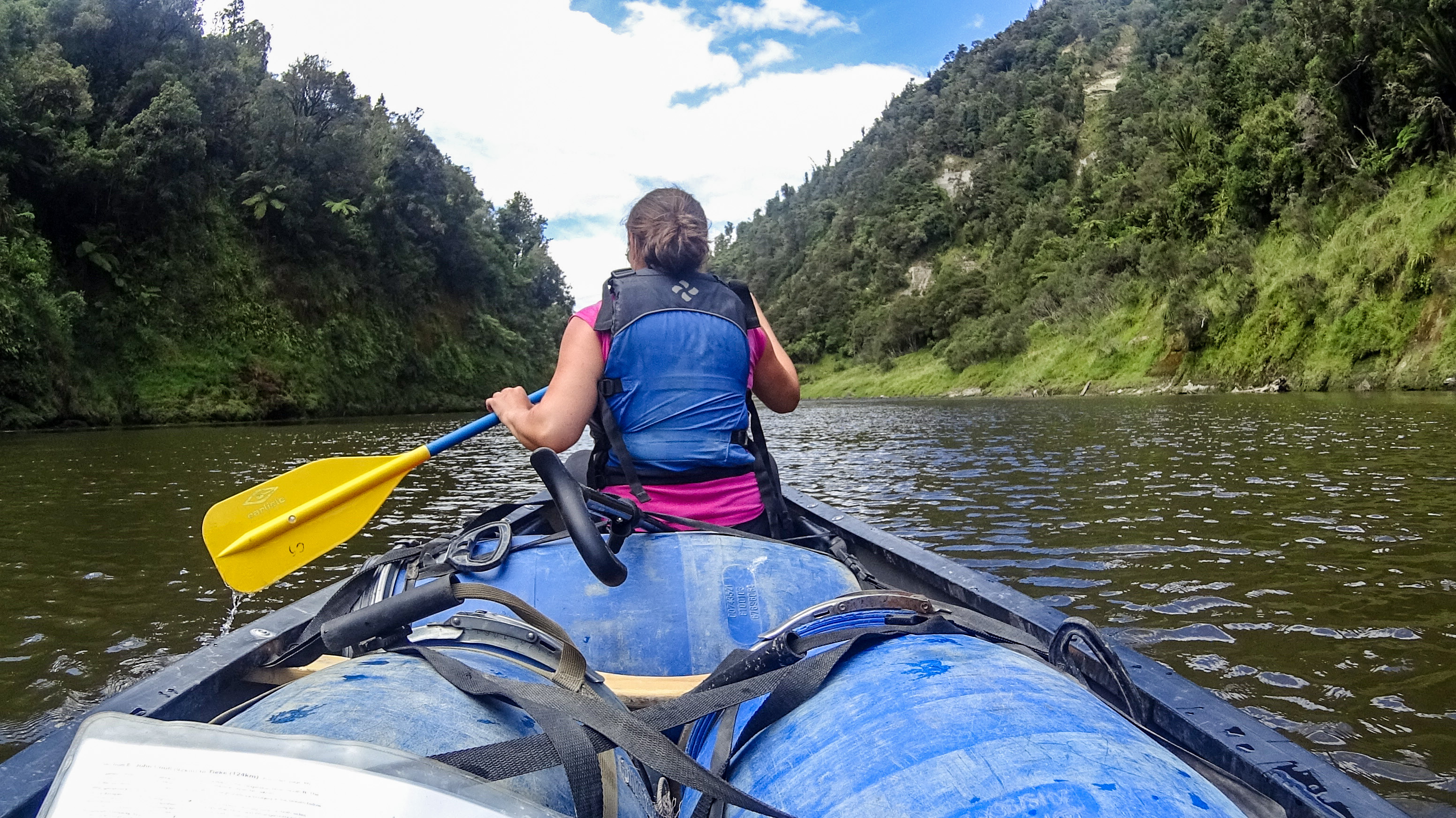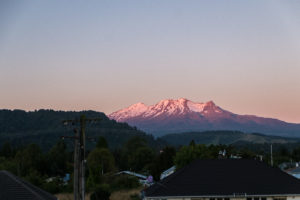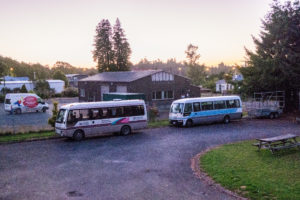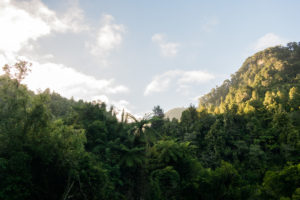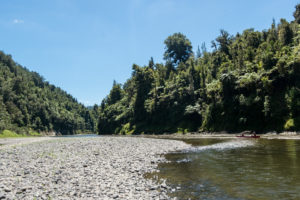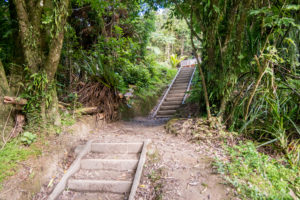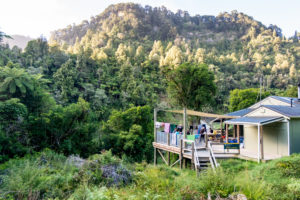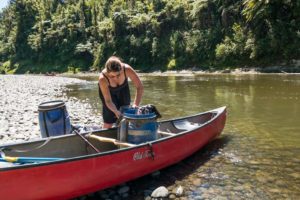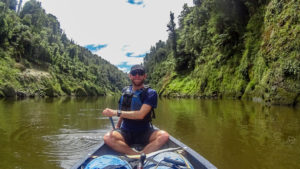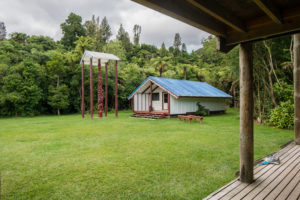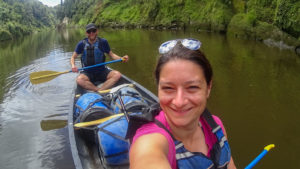Handicap and canoe : 3 days on the Whanganui River
Sommaire
Of few preparations before the departure
The Whanganui Journey is one of the 9 great walks of New Zealand and it is the only one with the amazing Abel Tasman Great Walk which can be fully done by kayaking or canoeing. Indeed, if you give a go to the Whanganui Journey you will paddle during 3 or 5 days, surrounded by nature, in the Whanganui National Park crossed by the same name river. If you choose to go for 3 days you will travel 88 kilometres. Whereas If you decide to go for 5 days of adventure you will have to paddle 145 kilometres. No matter what you choose do not forget to book your nights in the D.O.C’s huts or campsites beforehand if you would like to do this great walk during the high season (October to April).
Once it’s done you just need to pack your bags before your departure to this adventure! There are no shop on the Whanganui Journey so you would better not to forget something! Most importantly , take a big bottle of water that you will be able to refill and sufficient food for the three to five days. Here is some important items too : sleeping bag, kitchen utensil, toilet paper, sun cream, repellent and bin bags. There are no bins at the campsites and huts so you will have to keep your garbages with you. Bringing earplugs can be useful as everybody will sleep in the same room. If you are afraid to forget something feel free to have a look at the D.O.C list here.
Regarding this Great Walk accessibility I might as well tell you right away that it is not accessible at all for wheelchair users. Firstly as you will have to transfer from your wheelchair to the canoe and then the shuttles and huts are not accessible. This being said if you have the capacity to walk a bit, a friend to help you during transfer and the desire to go for canoe adventure do not hesitate. Just go for it and your efforts will be rewarded.
Let’s go to Okahune, a small city where we will reach the company renting canoes and where we will sleep the night before the beginning of this trip. Once we arrived we met the manager who explained us how things will be the following day. He also showed us your room and gave us three barils in order to fil them with stuffs we will take on the river. Think to put all the things you will need to access in the boat (water, sun cream, repellent, snacks) in the same baril. That way you’ll be able to reach them more easily. In half an hour that was done!
Once the Tetris baril game is over, it is time for our first reward: from our room we can see Mount Ruapehu also known as the Mordor in the Lord of the Rings trilogy. I am so glad to be able to contemplate this volcano once more, a few months after my first visit in Taupo and my first sit ski experience.
Day 1: From Whakahoro to John Coull Hut
Let’s go for 37 km to paddle on the river today. After 1h45 hours of shuttle drive we reach the starting point. The shuttle is not accessible as there are three steps to go in.
The bus dropped us off as close at the river as possible. Before we can finally sail alone we have to listen for some advices like how to paddle correctly, especially how to handle the bid rapids on the last day.
Once we’ve put the barils in the canoe and we put our life jackets on we finally start to paddle on the Whanganui River. We discover really beautiful landscapes. We slowly move forward in the middle of hills covered with very dense and wild vegetation. Sometimes we discover a craggy cliff. Once more there are a lot of ferns of every size. No doubts we are in New Zealand!
The more we progress the more we see little waterfalls and we can guess that there are more of them after a rainy day. Sometimes we stop paddling just to listen the waterfall sound and the song of Tui birds, New Zealand endemic bird. I enjoy listening to them so much! No other sound, we are so far away from the cities agitation. This day was perfect. The weather was sunny all day and the river was calm except for two or three little rapids and a few whirlpools at the end.
After 5h30 paddling we reach John Coull Hut where we will spend the night. It is a perfect occasion for me to do some exercise. After 5 minutes walking in a steep pathway, I must climb many steps to reach the hut. Well, I think you got it : huts are not accessible at all.
The hut surroundings are very pleasant. We enjoyed the last sunbeams on the deck while playing a card game with a Kiwi and a Canadian couples. In the hut you will find gaz cookers and a dorm with all the matresses are next to each others. The Ranger in charge of the hut was really kind and offered me to go in her private room to change my clothes if needed and she helped Franck to bring the barils from the river to the hut with the Canadian man.
Day 2 : From John Coull to Tieke Kainga
After a good night’s sleep, let’s go for 29km on the Whanganui River. Franck bring the barils down the river with the Canadian guy, come back to help me to go down and we load the barils in the canoe.
The morning starts in a good way: the sun, Tui birds and ferns are still here. Perfect! We still have to be careful as there are a lot of dead wood pieces the river causing current and rapids. We go through them without any issues but not every people is as lucky and we cross path with a couple of older people who capsized. Nothing bad : they succeed to reach the shore and now just have to empty the water from the canoe. They waste a lot of time but they were fine and that’s what matters.
During this second day we cross a lot of jet boats. All of them are going to the «Bridge of Nowhere» which is literally in the middle of nowhere. Well, in the middle of the bush to be exact. To reach it it takes about 1h20 return walking after you’ve attached the canoe at Mangapurua. As I do not have my wheelchair with me I cannot go there and Franck decide to stay with me. Nevertheless we still have a good time as we take advantage of this time to a swim in the river.
Tonight we sleep at Tieke Kainga Hut. As the previous one, it is hard to get to it but it is a good place to learn more about the maorie culture as there is a marae, a sacred meeting place for maoris people for religious or social events. Consequently it is forbidden to drink alcohol or smoke. On some days if the maoris are in Te Kainga you might enjoy a powhiri, a welcoming ceremony.
Day 3 : From Tieke Kainga to Pipiriki
During this third and last day we have to travel 21,5km. This is the shortest day because we have to finish by 2pm. The shuttles will wait for us at Pipiriki, the arrival point, and will bring us back to Okahune. The day begins very well as we enjoy the Whanganui Journey most interesting landscapes. The surrounding hills appears more impressive as the gorges tightens.
At the end of the travel the scenery is less pleasing as the gorges become wider and fields reappears. Although we still enjoy this last part as we have to go through the three biggest rapids of the Whanganui Journey. Like the others canoeists we feared them a bit and we accepted the idea of finishing the trip in the water. In the end, crossing all those rapids is the thing I preferred during these three days. And the Tui birds songs of course! Handling these waves gave me a lot of fun and a bit of challenge! I had a good laugh crossing them even if we could have capsize anytime. At the end we stayed dry, only three others canoes capsized and everybody succeeded to reach the arrival at time.
A short summary of this three days in two minutes!
After a 40 minutes shuttle ride to come back in Okahune and a 3h30 drive to Wellington, we are back home. This few days were so short, too short. I was waiting impatiently for this Great Walk and I wasn’t disappointed at all. Unlike what I feared I wasn’t too tired at the end and I didn’t get bored. I would like to continue to paddle for some more hours. I really liked being in the middle of the nature during three days without network and electricity. It made feel so good to be completely disconnected !
You want to travel all around New Zealand? Find many ideas of awesome destinations in north island and south island in my other articles as well as wheelchair accessibility tips.
Did you like this post? Feel free to check out my Patreon page to see how you can support the creation of new ones and be a part of iwheeltravel!
And of course, you can share, like and subscribe, to be aware of the lastest posts.

